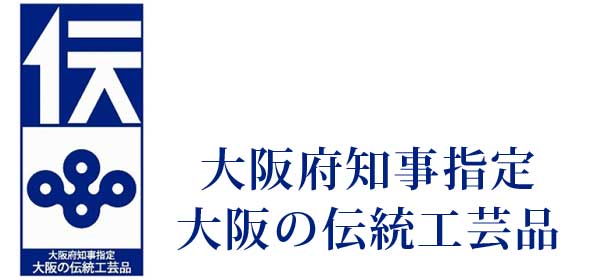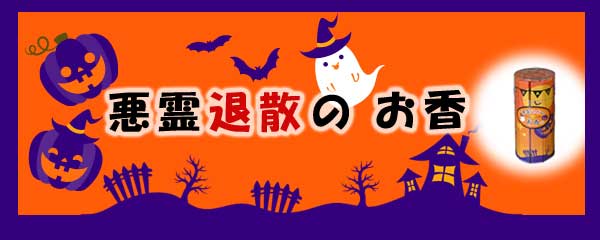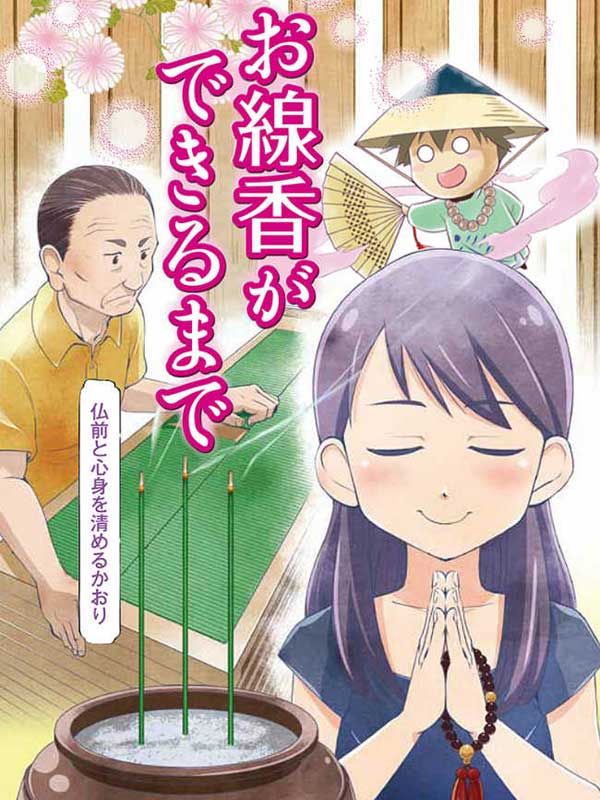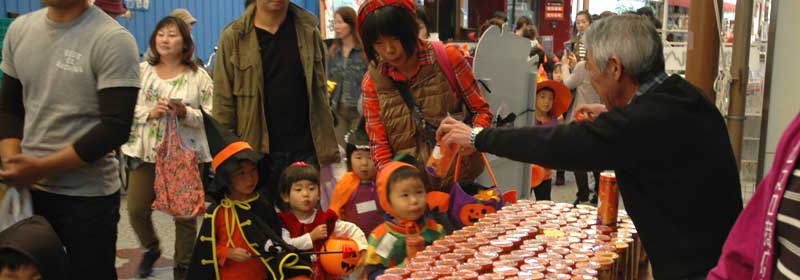
堺線香について
日本で最初に製造された堺線香
堺旧港は15世紀頃遣明貿易や東南アジア交易の日本の基地として、海外から様々な舶載品が輸入され、沈香・白檀などの香料も重要な交易品でありました。当時の堺はそれら貿易によって強大な経済力を持ち、絢爛たる文化の花が開き、「お香」の調合法も大いに研究されたのです。
現在の線状になったお線香は、16世紀に中国からその製法が伝えられ「堺」に於いて製造したのが線香製造のはじまりであるとされ、江戸時代以降は、今もその伝統技法と調合方法を受け継いでこの地で作られ続けています。
お線香は、『椨の木』皮を乾燥させて粉にしたものを基材に、沈香などの天然原料やその他香料を調合して作ります。椨の木の皮は、粉末にして焚いても匂いが少なく、様々な香りの邪魔をしません。
この粉末に水分を加えると、適当な粘りけがでて棒状に加工する線香造りには大変重要な役目を果たしています。
Sakai Incense - the first to be manufactured in Japan
In the 15th Century, The old port of Sakai was an important trade center between Japan, the Ming Dynasty in China and south-east Asia. Aloeswood (also known as Agarwood) and Sandalwood were some of the important trade goods from overseas which were imported here.Kyara is Japanese for the highest grade of Aloeswood, and Jinko is the standard variety.
Byakudan is the Japanese name for Sandalwood.
In those days, Sakai was a strong economic power through its trade. A golden age of culture blossomed and sophisticated incense preparation methods were studied and developed on a large scale.
In the 16th century, today’s well known stick incense was introduced from China and the first production in Japan was in Sakai. Since the Edo period (1603-1868) traditional compounding and production techniques have been refined and passed down. Incense continues to be produced in Sakai to this today.
Our Incense is made by blending powdered Aloeswood and other fragrances. At its base is the powdered bark from a species of laurel (Machilus thunbergii); used because it is virtually odorless and doesn’t produce much smoke.By adding water to the powdered laurel bark it becomes highly sticky; this is necessary for producing linear-shaped ‘sticks’.
マンガ「堺の線香」
昭和63年に出版された「マンガ堺の伝統産業」(堺市中小企業振興会編集)の中に、堺線香について分かりやすく紹介されています。作画は桃山学院大学漫画研究会の皆さんによって作られました。
こちらで、マンガを閲覧することが出来ます。
“The Incense of Sakai” A manga/comic strip
The incense of Sakai was introduced and described in a manga/comic strip published in 1988, titled, “Traditional Industry of Sakai” The drawings were made by members of the ‘Society for the Study of Manga’ from St. Andrews University in Osaka. It was edited by Sakai City Industrial Promotion Center.
堺線香「商品ノ起源」
当組合の沿革にて掲載しました「堺の薫物線香」(堺薫物線香商組合 明治43年)の沿革史の中に、堺線香の由来について詳細に書かれています。その一部を抜粋し、解説を加えてご紹介いたします。
―略―
堺市ハ往古ヨリ、安南、交趾、呂宗ヲ始メ、外国ノ貿易船、当津二、輻輳セルニヨリ、伽羅、沈香及ビ、香類雑貨、船載交易スルコト久シ、此ニ於テ市内ニ唐物問屋多ク、而シテ香類ハ唐物問屋ニ於イテ売買セラレル、享禄、天文ノ頃、香類ノ風雅ノ隠士市中ニ佳シ中ニモ牡丹花肖柏1)老人殊ニ香ヲ愛賞シ相継テ坂宗拾2)等ノ名士数人出テヨリ香ノ秘方ヲ当時ノ商人ニ伝ヘラレ種々ノ香ヲ製出セシメラレタリ
之レ他、地方ニアラザリシカ故ニ、当津ノ名産トシテ海内ニ伝播スルニ至り、沈香屋ト称シ、香類ヲ専門ニ商フモノ相継テ起ル天正年間堺、宿屋町薬種商、小西弥十郎如清3)ト云フ人渡韓ノ際、彼地ニ於テ、線香製造ノ法ヲ伝習シ来リ、堺ニ製造ヲ、ナシタルヲ、我国ニテ、線香製造ノ初トス、而シテ当市ハ往古ヨリ香ノ配合ノ秘方伝リアルカ故ニ、之レヲ、線香ニ応用ヲナシタルヲ以テ、我国ニ産スル中ニモ、最モ佳品トシテ、賞揚セラル。
―略―
堺市ハ往古ヨリ、安南、交趾、呂宗ヲ始メ、外国ノ貿易船、当津二、輻輳セルニヨリ、伽羅、沈香及ビ、香類雑貨、船載交易スルコト久シ、此ニ於テ市内ニ唐物問屋多ク、而シテ香類ハ唐物問屋ニ於イテ売買セラレル、享禄、天文ノ頃、香類ノ風雅ノ隠士市中ニ佳シ中ニモ牡丹花肖柏1)老人殊ニ香ヲ愛賞シ相継テ坂宗拾2)等ノ名士数人出テヨリ香ノ秘方ヲ当時ノ商人ニ伝ヘラレ種々ノ香ヲ製出セシメラレタリ 之レ他、地方ニアラザリシカ故ニ、当津ノ名産トシテ海内ニ伝播スルニ至り、沈香屋ト称シ、香類ヲ専門ニ商フモノ相継テ起ル天正年間堺、宿屋町薬種商、小西弥十郎如清3)ト云フ人渡韓ノ際、彼地ニ於テ、線香製造ノ法ヲ伝習シ来リ、堺ニ製造ヲ、ナシタルヲ、我国ニテ、線香製造ノ初トス、而シテ当市ハ往古ヨリ香ノ配合ノ秘方伝リアルカ故ニ、之レヲ、線香ニ応用ヲナシタルヲ以テ、我国ニ産スル中ニモ、最モ佳品トシテ、賞揚セラル。
―略―
解説
堺市は古来より、東南アジア諸国をはじめ、諸外国の貿易船が行き交い伽羅・沈香などの香類や雑貨を、交易することとなりました。
市内には中国、東南アジアの品々を扱う問屋(唐物問屋と云う)などが多く、なかでも香類は、この唐物問屋において売買されており、江戸享禄・天文の頃、お香・お茶の道を究めた風雅な方々が市内に現れて、お香の調合法を当時の堺商人に伝え、数々の香りを商品化できるようになりました。
この製法は今も一子相伝を守り続け伝えられることとなり、その秘宝を持つものが、沈香屋と称され、今日にいたっております。そして中でも宿谷町の小西弥十郎という薬種問屋の方が天正年間、韓国に渡った際に、中国から韓国に伝わった線香の作り方を学び、当地に持ちかえり、古来から堺に伝わるお香の調合を応用して、広く商う良い香を作り続けることとなり、今日でも佳品として賞賛されております。
注釈
1) 牡丹花肖柏(ぼたんげしょうはく、嘉吉3年(1443年)- 大永7年4月4日(1527年5月4日))は、
室町時代中期の連歌師。応仁の乱の後、晩年に堺に移住し、「古今和歌集」「源氏物語」の秘伝を堺衆に伝え、堺伝授の祖となった。
2) 恐らく坂内宗拾(曽呂利新左衛門)を指すと思われる。
豊臣秀吉に御伽衆として仕えたとされる。落語家の始祖と言われ、数々の逸話を残した。元々堺で刀の鞘を作っていて、その鞘には刀がそろりと合うのでこの名がついたといわれる。また武野紹鴎に茶道、志野宗心に香道を習い、和歌にも通じていたとされる。
3) 小西弥十郎如清 小西如清とは小西行長の兄を指すが、この薬種問屋小西弥十郎如清とは、父の小西隆佐を指すと思われる。ルイス・フロイスに師事しキリシタンとなる。その後秀吉に仕え、河内国・和泉国における豊臣氏の蔵入地の代官に任命。天正20年(1592年)、朝鮮出兵が始まると肥前名護屋城に入るが、まもなく発病して堺から京都に戻り、そのまま死去した。
Explanation
For a long time, Sakai city was a major ‘hub’ port in south east Asia; with many foreign vessels continually arriving. They traded general goods and incense: “Kyara” (high quality Aloeswood) and “Jinko” (Aloeswood)."Many wholesalers of Chinese and south east Asian goods in Sakai traded in aromatic woods.Around 1730, experts who had mastered tea and incense-smelling ceremonies. Introduced these aesthetics to merchants. Due to this popularization, production of various kinds of incense became commercialized.
Production methods have been passed down through families; from the father to only one of his sons. Only the inheritor is called "Jinko-ya" and this still remains unchanged.Yajuro Konishi a traditional herbalist lived in Yadoya-Cho. He learned how to make incense sticks when visiting Korea in the Tensho Period (1573 - 1592) and subsequently introduced it to Sakai. So, from that time high quality incense utilizing the traditional compounding method has been produced here.
椨(たぶ)の木 クスノキ科タブノキ属(学名Machilus Thunbergii)
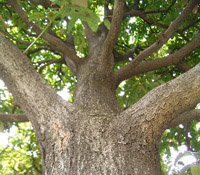
|
お線香は、仏や世界を遍く照らす光明の役割を担っている為、椨の木は名前の由来といい素材といい、お線香に無くてはならない樹木です。
Tree of "Tabu", a type of Laurel, Genus Machilus of Lauraceae
(Scientific Name : Machilus Thunbergii)
The Tree of Tabu was called tree of "Tama" (tama means spirit). It is a broad-leaved evergreen tree, vivid and tall which always has glossy leaves. It was once believed that a divine spirit dwelt in this tree.From Tama to Tamu eventually, coming to be called the tree of "Tabu"
The incense sticks take the role of shining a light on the Buddha and the world at large. The tree of Tabu is indispensable both in material terms and in the origin and meaning of its name.
